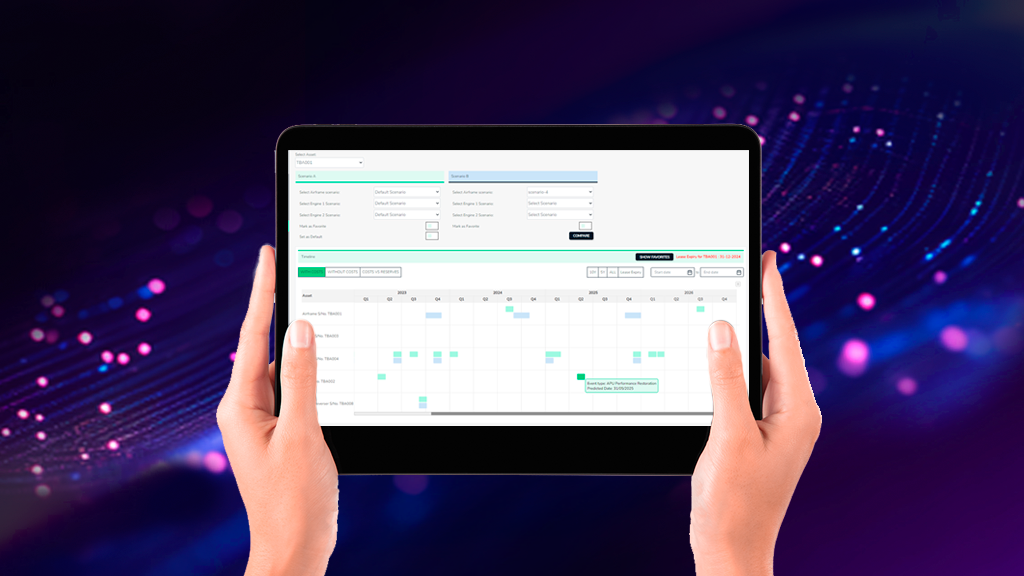
How aircraft lease management software can reduce transition risk
Author:
Lloyd White
Product Manager – Lifecycle Asset Management (LAM)
Aircraft leasing has become increasingly common over the last few decades, with airlines valuing the flexibility to expand their fleet without the substantial capital expenditure of a fully owned model.

However, this doesn’t mean it’s a simple solution. There are complex contracts, regulations, years of forward planning and continuous collaboration between stakeholders to consider, not to mention all of the risks that come with this strategic balancing act if you get it wrong.
Unless carefully planned, aircraft lease transitions carry high potential risk for operators, with particular challenges such as unscheduled, last minute maintenance, resource demand and meeting complex contractual obligations often causing delays. Many airlines simply don’t have the dedicated resource to manage redeliveries – especially when their primary focus is on revenue operations while the aircraft in service.
So, what are the benefits of aircraft lease management software that help reduce the risks airlines face during transition?
Key benefits of aircraft lease management software
Clear documentation and compliance
Clarity and accuracy of records are often a concern for both airlines and lessors. Specifically, it challenges those operators who are focused on manual records management – for example, locating stored records, ensuring they’re correctly audited and cross-checking them to ensure compliance can all take days or weeks without a digital process in place. Lessors also face the costs of hiring auditors to ensure records provided by the airline are accurate and meet lease return conditions.

Instead, digital aviation and asset management software can ease the process for both parties. All lease agreements and technical documents are digitally stored and easily accessible in a dedicated Records Management platform with key data extracted, which allows the user significant time saving in searching, auditing and collating relevant documents.
Firstly, it’s simpler for airlines to compare lease agreements with live engineering operational data, ensuring that maintenance windows are maximised throughout the lease term to confirm their assets are contractually compliant when it comes to redelivery. For example, flydocs Lifecycle Asset Management (LAM) software automates the interpretation of lease contracts and notifies you whether your assets are meeting return conditions in their current and predicted future state.
Secondly, with an easy method of managing and auditing documents, both airlines and lessors can be assured that their assets’ technical records are accurate, compliant and up-to-date, helping to protect their asset value and reducing the risk of compliance penalties.
Reduced risk of missing redelivery deadlines
One of the most important challenges we often see is how airlines struggle to plan ahead for transition periods, due to the intensity of managing day-to-day operations and a lack of specific knowledge in handling these complex projects. Ideally, transition planning should begin up to 24 months before a lease return to avoid some of the challenges we’re talking about here.
Our guide to the airline redelivery process is available to give you an idea of what this time should look like.
Aviation lease management software can help in several ways. Firstly, the time saved on managing the technical records process frees up resource to be better utilised on other redelivery tasks or day-to-day operations.
Secondly, software like LAM gives a view of your technical records and lease return conditions to bring you personalised and live dashboards in real-time. This gives you a holistic view of all your assets with a single glance, making it quicker and easier to view the status of each asset, make informed decisions and avoiding errors that can compound and lead to missed redelivery deadlines.
Instead, with software at hand to give that top-level overview, airlines can forecast important milestones, allowing suitable time for maintenance per asset well in advance.

Cost and risk avoidance
Of all the redelivery-related challenges an airline faces, late redelivery penalties can be the costliest of all to an airline. We’ve already talked about freeing up resource and optimising maintenance windows, which in turn can lead to meaningful cost savings in themselves.
However, another big area where the costs can quickly stack up is late lease return penalties. With late penalties often stacking up into hundreds of thousands, it’s no wonder that airlines are looking for software to make this process more efficient and avoid the hit to their bottom line.
Lease return software such as LAM offers advanced digital tools to streamline solutions, reduce errors and improve productivity, making it easier to identify risks of penalties and therefore managing and helping to prevent unseen costs.
Software features such as maintenance event trackers provide a view of the data needed for cost-effective decision-making, particularly when it comes to maximising asset utilisation and optimising fleet planning. This gives you the opportunity to be as efficient as possible with each asset, minimising downtime and extending the aircraft’s operational life to generate extra revenue.

Communication and collaboration
LAM gives you a one-stop destination for your aircraft asset data so your engineering, commercial and legal teams can work collectively on a shared platform using accurate information.
This is a simple yet fundamental feature of our software which improves collaboration, reduces confusion and sees team productivity and efficiency soar.
By allowing technical and asset managers to work together on planning for redeliveries, it ensures that both vital aircraft maintenance and the financial implications of any necessary downtime are considered well in advance.
To round up, as aircraft leasing becomes a more popular option for airlines, it’s pivotal that efficiency, precision and adherence to regulations is top of the priority list. As the aviation industry continues to evolve, aircraft lease management software will become a decisive tool in transition management.
Why flydocs?
With years of experience in aircraft asset management, from on the ground involvement in the complexities of technical project management to our software and technology, we’ve learnt a thing or two about where the most common risks are and how to mitigate them.
By using our Lifecycle Asset Management software, airlines are empowered to efficiently and accurately manage their assets, whilst simplifying the process and reducing the complications and risks associated.
By providing real-time data and enhancing communication, our software will streamline operations and improve financial management, while identifying and mitigating potential risks. It’s a valuable tool to reduce transition risk and ensure a smoother leasing process overall.
Want to learn more?
Get in touch with Lloyd or the flydocs Sales team for a more in-depth walkthrough around your tailored needs.
